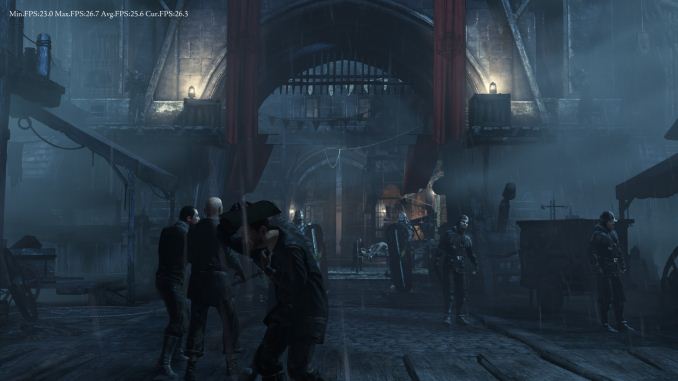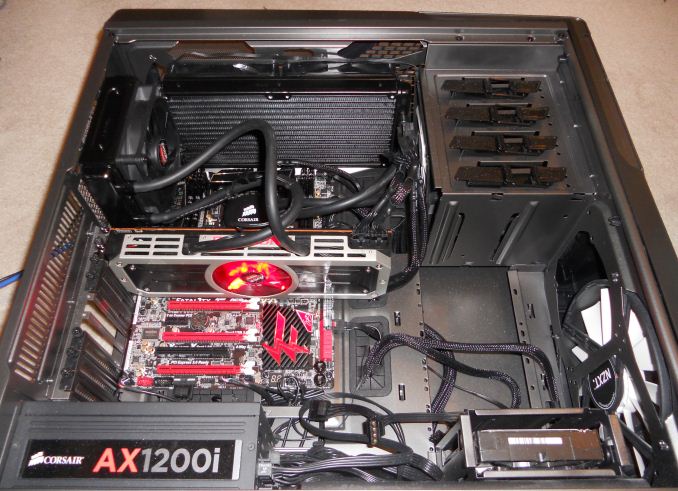The AMD Radeon R9 295X2 Review
by Ryan Smith on April 8, 2014 8:00 AM EST- Posted in
- GPUs
- AMD
- Radeon
- Radeon 200
The Test
Starting with today’s article we’ve made a small change to our suite of games. We are replacing our last 2012 game, Hitman: Absolution with another Square Enix title: the recently released Thief. Both games make use of many of the same graphical features, and both games include a built-in benchmark that is a good approximation of what a worst case rendering load in the game will behave like, making Thief a solid replacement for the older Hitman.
Meanwhile we’ve also updated all of our benchmark results to reflect the latest drivers from AMD and NVIDIA. For all AMD cards we are using AMD’s R9 295X2 launch drivers, Catalyst 14.4. Catalyst 14.4 appears to be a new branch of AMD’s drivers, given the version number 14.100, however we have found very few performance changes in our tests.
As for NVIDIA cards, we’re using the just-launched 337.50 drivers. These drivers contain a collection of performance improvements for NVIDIA cards and coincidentally come at just the right time for NVIDIA to counter AMD’s latest product launch.
We also need to quickly note that because AMD’s Radeon R9 295X2 uses an external 120mm radiator, we’ve had to modify our testbed to house the card. For our R9 295X2 tests we have pulled our testbed’s rear 140mm fan and replaced it with the R9 295X2 radiator. All other tests have the 140mm fan installed as normal.
| CPU: | Intel Core i7-4960X @ 4.2GHz |
| Motherboard: | ASRock Fatal1ty X79 Professional |
| Power Supply: | Corsair AX1200i |
| Hard Disk: | Samsung SSD 840 EVO (750GB) |
| Memory: | G.Skill RipjawZ DDR3-1866 4 x 8GB (9-10-9-26) |
| Case: | NZXT Phantom 630 Windowed Edition |
| Monitor: | Asus PQ321 |
| Video Cards: |
AMD Radeon R9 295X2 AMD Radeon R9 290X AMD Radeon R9 290 AMD Radeon HD 7990 AMD Radeon HD 6990 NVIDIA GeForce GTX Titan Black NVIDIA GeForce GTX 780 Ti NVIDIA GeForce GTX 780 NVIDIA GeForce GTX 690 NVIDIA GeForce GTX 590 |
| Video Drivers: |
NVIDIA Release 337.50 Beta AMD Catalyst 14.4 Beta |
| OS: | Windows 8.1 Pro |












131 Comments
View All Comments
Kevin G - Tuesday, April 8, 2014 - link
Typo:"The PCB itself is 14 layers, making it an especially intricate PCB, but one necessary to carry 500W while also routing 1028 GDDR5 lines and 48 PCIe 3 lanes."
I presume 1028 is actually representative of the combined 1024 bit wide memory bus.
Ryan Smith - Tuesday, April 8, 2014 - link
Noted and fixed. Thank you.CiccioB - Tuesday, April 8, 2014 - link
Isn't 500W from 2x8 + PCI-E out of standards and connctor specifics and somewhat dangerous?ShieTar - Tuesday, April 8, 2014 - link
Its out of spec, as also discussed in the article, but very unlikely to be dangerous. 215W at 12V over 3 wires will draw about 6A per wire, still significantly below what the ATX standard considers safe:"Under normal or overload conditions, no output shall continuously provide more than 240 VA".
The interesting question will be if the PSUs are up to the task of filtering the rapid switching between almost 0W and up to 425W on the rail which feeds the two connectors. But most modern, high power PSUs feed even more connectors on a single rail, so they should have little problem. And whoever mates a 1500$ GPU with a cheap PSU has nobody to blame but himself.
LoccOtHaN - Tuesday, April 8, 2014 - link
Really fine Card for 4k gaming. Nice Job AMD/ATI and 1498$ is not expensive for Entusiast Level of Hardware. NICECiccioB - Tuesday, April 8, 2014 - link
Broken frame pacing does not really put this card as the best choice for playing, IMHO.LasseGrr - Tuesday, April 8, 2014 - link
@CiccioB Maybe try reading the article again...CiccioB - Tuesday, April 8, 2014 - link
You may look at those frame per seconds graphs more closely. When provided, those graphs do not show good frame pacing timings, and where not provided, look to other site's reviews.But then, I'm sure who ever spend $1500 for a gaming card has all the reason to convince himself that the card is good nonetheless.
extide - Tuesday, April 8, 2014 - link
What are you talking about?? First of all, an FPS graph shows NOTHING about frame timing variance.Second of all, they DO specifically show the frame timing, in different graphs, and it is fine, very similar to nVidia's results!
Are you not able to read or something?!
CiccioB - Wednesday, April 9, 2014 - link
Sorry, but what kind of graph are you looking at?First, not all reviewed games here have a frame pacing graph.
Second, look at BF4, Crysis3, Thief graphs for example. Where do you see this card being better than a SLI of 780Ti?
The FPS graphs are a mess for this 295x2. Ideally those graphs should be a thin line, not an area where the frame per seconds continously oscillate.
But, well, as said, once you spend (or want to spend) $1500 you have to convince yourself there are no problems. The same was true for 7990 buyers that glorified that card. See now what a crappy card it is. And that was also true for all those that negated that AMD Crossfire configurations had problem with respect to nvidia ones before AMD tried to correct the problem with new drivers (that somewhat now work for DX11 games but not with DX9 and 10 ones, and that's maybe the reason that for older games there's not the frame pacing graphs...).